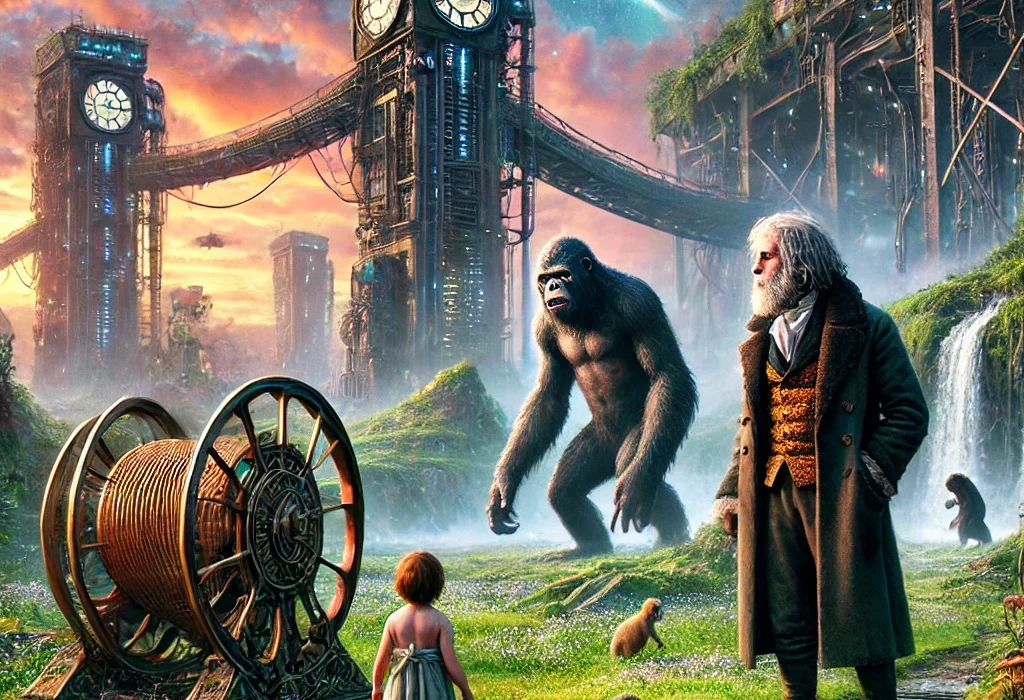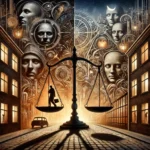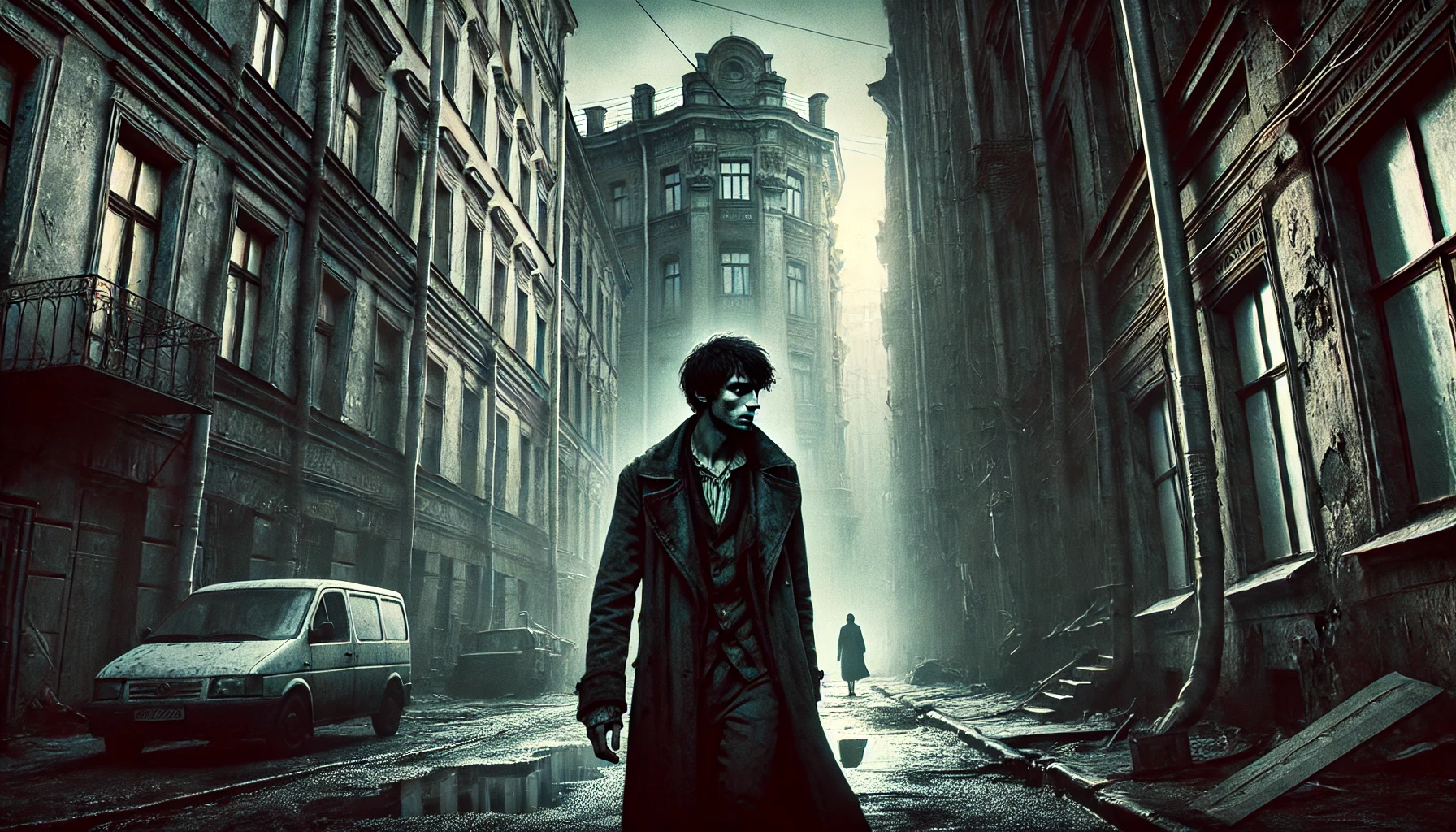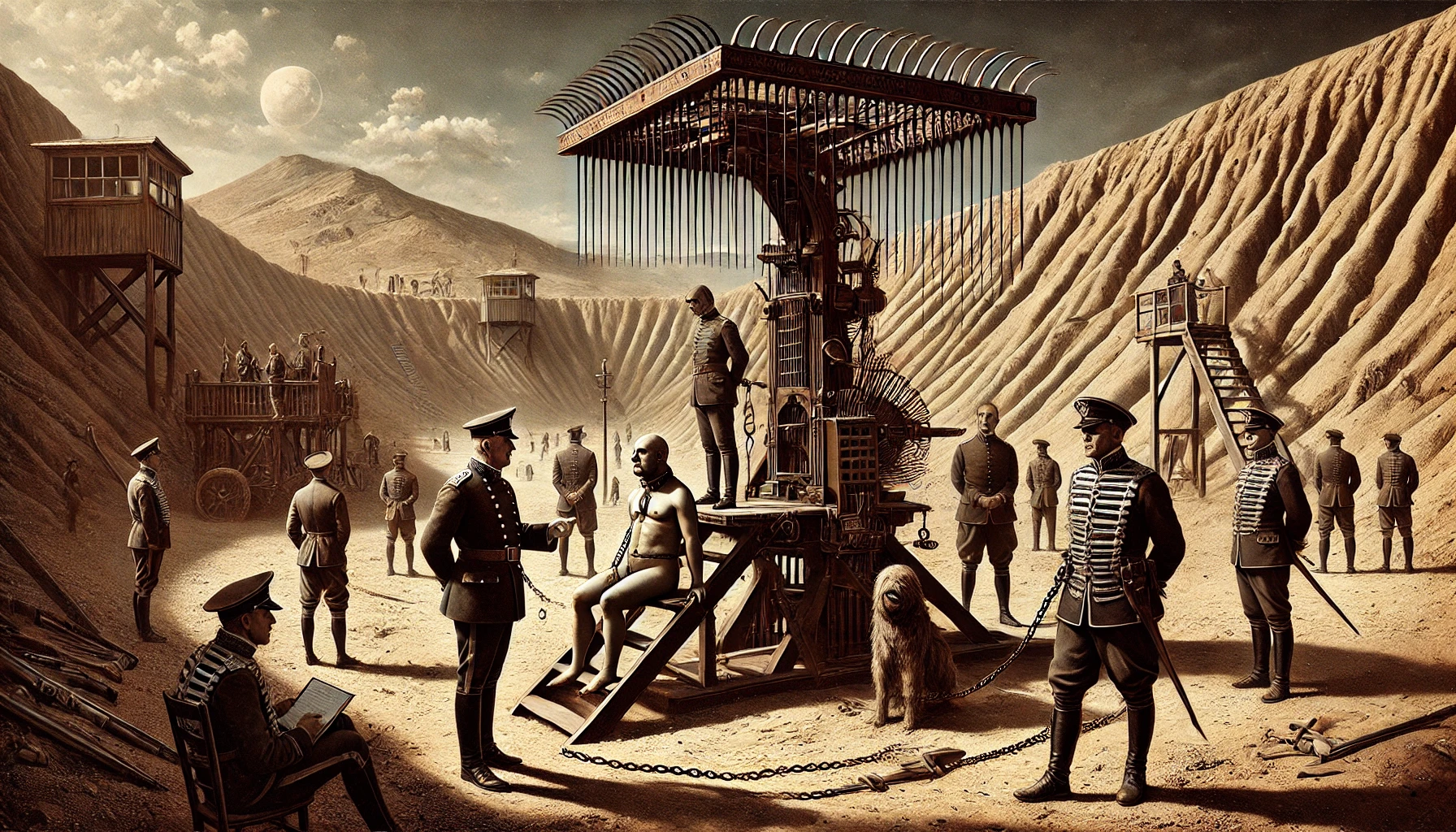The Time Machine is a science fiction novel written by H.G. Wells, first published in 1895. This pioneering work explores the concept of time travel, venturing into both the distant future and the philosophical implications of such a journey. Through the protagonist’s adventures, Wells delves into issues such as class division, human evolution, and the ultimate fate of humanity, making the novel a cornerstone in the genre of speculative fiction.
Plot Summary
The fire crackled warmly in the drawing room, but the conversation among the guests was anything but ordinary. The Time Traveller, a man whose intellect and inventions had long intrigued his friends, was about to unveil something extraordinary. His grey eyes gleamed with the fervor of discovery as he explained a concept that confounded his companions—time as the fourth dimension. He spoke of moving through time as one would through space, using a machine he had built. Despite their skepticism, the guests followed him to his laboratory, where he revealed a small, intricate machine. With a flick of a lever, the model vanished before their eyes, leaving them in stunned disbelief.
Days later, the Time Traveller returned, disheveled and pale, as if he had lived through ages. Over dinner, he promised to explain his incredible journey and led his guests into the smoking room. Once seated, he began recounting the most astonishing tale of his life—a journey into the future.
It began when he completed his full-sized time machine and set forth on a journey into the unknown. As the machine whirred to life, the familiar surroundings of his laboratory blurred. Day turned to night in rapid succession, and the seasons flickered like a faulty lantern. Faster and faster he went, watching the Earth evolve beneath him. Finally, he slowed down and stopped in the year 802,701 AD.
Stepping out of the machine, he found himself in a garden of an unimaginable future. The air was warm, the landscape serene, and the sky a brilliant hue. Soon, he encountered the Eloi, a small, delicate race of people who lived in a seemingly idyllic world. They were beautiful but childlike, lacking curiosity or intellect. Though they welcomed him with garlands of flowers and led him to their vast communal halls, the Time Traveller was disturbed by their simple-mindedness. They showed no interest in the past, no desire for knowledge, and lived in an effortless existence, eating only fruit and playing in the sun.
As he explored further, his initial enchantment faded. The Eloi’s utopian world held dark secrets. One evening, he discovered that his time machine had vanished. Panic set in as he realized he was trapped in this distant future. He searched frantically, but the machine was gone, and the Eloi were too indifferent to help.
His investigation led him to the terrifying truth—the machine had been taken by the Morlocks, a race of pale, ape-like creatures who lived underground in the darkness. The Morlocks, the antithesis of the Eloi, were the keepers of the machinery that sustained the upper world, but they lived in squalor and fear of the light. These creatures emerged at night, and the Time Traveller realized that the Eloi, for all their beauty, were no more than cattle for the Morlocks, who hunted them in the darkness.
Determined to retrieve his machine, the Time Traveller ventured into the lair of the Morlocks. Armed with nothing but matches for light, he descended into their underground world, a maze of tunnels and mechanical rooms. The smell of decay filled the air, and the machines rumbled ominously in the distance. It was here that he saw the Morlocks at work—brutish, blind creatures who moved with terrifying coordination in the dark. He barely escaped with his life, retreating to the surface with newfound horror at the fate of humanity.
Yet, hope glimmered faintly. The Time Traveller befriended an Eloi named Weena, a fragile creature who clung to him for protection. She symbolized the innocence and fragility of the Eloi race, and in her, the Time Traveller found a reason to stay. They wandered through the ruins of ancient buildings, remnants of a world long forgotten, and he marveled at the decay of human achievement. But the nights grew more dangerous as the Morlocks became bolder. On one such night, while trying to start a fire for protection, the Time Traveller lost Weena in the chaos. The Morlocks attacked, and in the darkness, Weena disappeared, leaving him devastated.
Desperate to escape this grim future, the Time Traveller made one final, daring attempt to retrieve his machine. In a climactic confrontation, he fought off the Morlocks and managed to climb into the machine just as they closed in on him. With a flick of the lever, he hurtled forward in time, leaving the terrifying creatures behind.
He ventured even further into the future, where he witnessed the slow death of Earth itself. The planet grew colder, the sun dimmed to a red orb, and life as he knew it disappeared. Strange, crab-like creatures crawled across the desolate landscape, and the oceans had frozen into ice. It was a haunting vision of the end of the world—one of silence, stillness, and inevitable extinction. Horrified, the Time Traveller returned to his machine and sped back to his own time.
When he finally stopped, he found himself back in his laboratory, shaken but alive. His guests, having listened in stunned silence, were divided—some believed his story, while others dismissed it as a delusion. The Time Traveller, undeterred by their disbelief, promised to make another journey through time. The very next day, he vanished once again, this time without a trace, leaving only his empty laboratory and the memory of his incredible tale.
Main Characters
The Time Traveller: The protagonist of the novel, a scientist and inventor who builds a machine capable of traveling through time. His curiosity and desire for knowledge propel him into the distant future, where he encounters civilizations that challenge his understanding of human progress. His character represents the archetypal scientist driven by discovery, but his journey exposes him to the horrors of human decline.
The Eloi: A gentle and childlike race that the Time Traveller encounters in the year 802,701 AD. They live in apparent utopian harmony, but their lack of intellect and physical strength reflects the stagnation of their society. Their existence represents the dangers of complacency and the eventual degeneration of the human race.
The Morlocks: The antagonistic underground dwellers in the future world, representing the darker side of human evolution. They are brutish and predatory, controlling the means of survival by maintaining the machinery that keeps the Eloi alive. Their existence symbolizes the industrial working class in Wells’s time, who toiled underground and were often unseen by society.
Theme
Class Conflict and Social Commentary: Wells uses the Eloi and Morlocks to comment on the growing divide between the upper and lower classes in Victorian society. The Eloi represent the idle upper class, while the Morlocks symbolize the oppressed working class, who eventually rise to dominance in a twisted inversion of societal roles.
Evolution and Human Decline: The novel explores the idea that human progress is not inevitable and that evolution can lead to degeneration as well as advancement. The Eloi and Morlocks are products of this concept, showing how the division of labor and environment shapes humanity in drastically different ways.
The Inevitability of Time and Decay: Through the Time Traveller’s journey to the distant future, Wells contemplates the ultimate fate of the Earth and humanity. The scenes of a desolate future where life has almost completely disappeared raise questions about the impermanence of civilization and the relentless march of time.
Science and its Consequences: Wells reflects on the potential consequences of scientific discovery and the hubris of trying to control nature. While the Time Traveller’s invention of the time machine represents human ingenuity, the world he discovers through it suggests that technology and progress can lead to unforeseen and even dangerous outcomes.
Writing Style and Tone
H.G. Wells’s writing in The Time Machine blends Victorian eloquence with a modern scientific sensibility, allowing readers to ponder philosophical questions through the lens of an engaging narrative. His style is detailed and vivid, particularly when describing the strange future landscapes and creatures encountered by the protagonist. He uses a first-person narrator, framing the story as a recounting of the Time Traveller’s adventures, which creates an intimate, yet speculative tone.
The tone of the novel shifts between intellectual curiosity and a growing sense of horror as the protagonist delves deeper into the consequences of time travel and the bleak future of humanity. Wells juxtaposes the excitement of discovery with a somber reflection on the darker possibilities of evolution and societal collapse, leading to an overall tone that is both thought-provoking and unsettling.
We hope this summary has sparked your interest and would appreciate you following Celsius 233 on social media:
There’s a treasure trove of other fascinating book summaries waiting for you. Check out our collection of stories that inspire, thrill, and provoke thought, just like this one by checking out the Book Shelf or the Library
Remember, while our summaries capture the essence, they can never replace the full experience of reading the book. If this summary intrigued you, consider diving into the complete story – buy the book and immerse yourself in the author’s original work.
If you want to request a book summary, click here.
When Saurabh is not working/watching football/reading books/traveling, you can reach him via Twitter/X, LinkedIn, or Threads
Restart reading!








